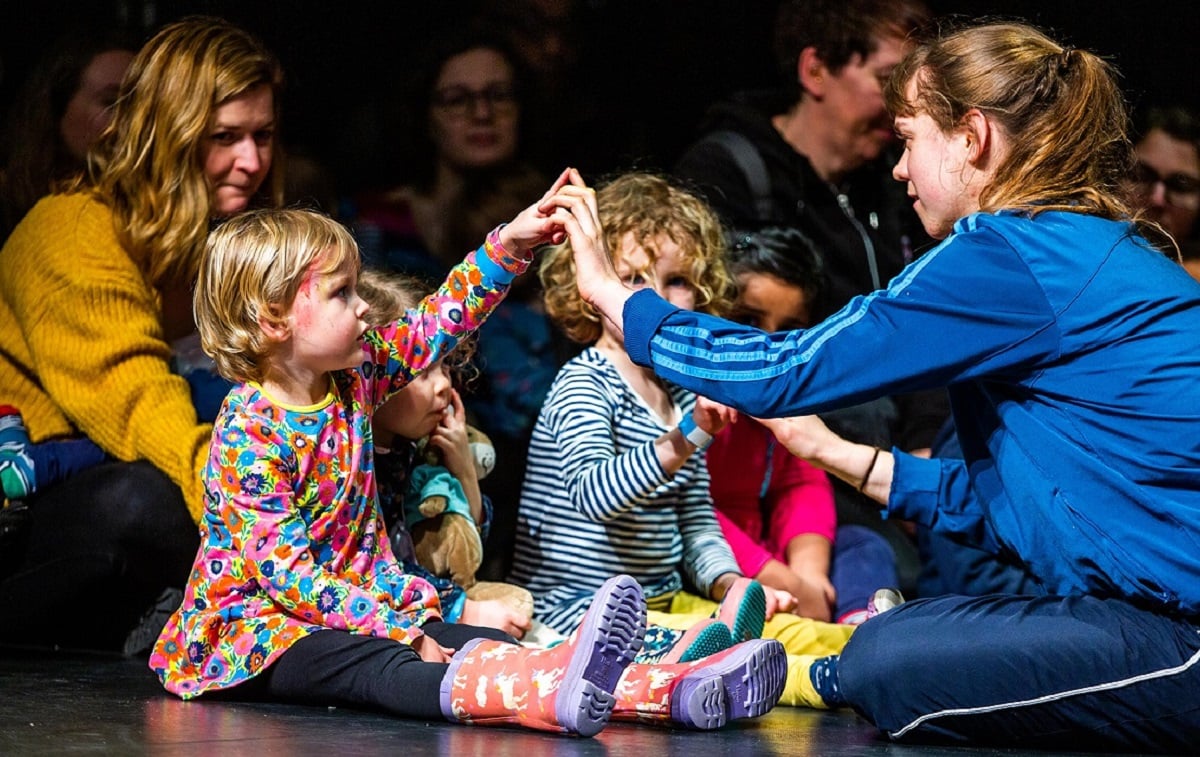
Photo: Summer Dean
Challenging ideas about children’s dance
Performers and providers often treat young children as a passive audience. Dr Angela Pickard says they can actively create and engage – and give feedback too.
Dance has potential benefits for child development in terms of educational, cognitive, behavioural and social outcomes, both in the short and long term. Some evidence suggests the positive impact is greatest on children from the most disadvantaged backgrounds. Engagement with dance for under-fives is a creative way to build physical co-ordination, confidence, thinking and problem-solving skills, encouraging expression and diminishing social and cultural distinctions.
But performances aimed at a young child audience often make assumptions about how this group thinks and learns. Young children are often viewed as passive with limited ability. Artists may not be aware of child development and how able young children can be to engage with dance and performance, cognitively and physically.
Little Big Dance aims to change that by contributing to sector knowledge. Our learnings will be relevant not just to dance, but to artistic practice generally.
Performing through play
The brainchild of South East Dance in collaboration with Yorkshire Dance, Take Art and Dance East, Little Big Dance is a three-year national project spanning four UK regions. It places children under five at the heart of creating dance performances.
Young children are usually enthused and curious about the world and often readily participate. They usually enjoy moving and are developing their gross and fine motor control. They can move fast and slowly, in straight lines and in different directions, and can make some shapes with their bodies. They can watch and copy others, create their own ideas in movement and enjoy an appropriate challenge, such as attempting stillness. Young children enjoy exploring through play and objects as well as through creativity and imagination. They can begin to make connections to prior experiences and start to problem-solve.
Little Big Dance will create a network of early years practitioners and arts organisations at a national level, increase access to high-quality dance performance for under-fives from low-income families, and for children from diverse ethnic and cultural backgrounds. The uniqueness of the project is that it places young children at the centre of the project, through access to creative and contemporary dance.
With and for children
The project is a response to the scarcity of high-quality early years dance provision and performance in the UK. Our goal is to bring dance to the most deprived areas of the country – those identified as having disproportionately low engagement in the arts.
In partnership with early years specialists and (adult) dance artists acting as facilitators, groups of young children take part in creative dance sessions and teach the artists how to work with them and for them.
The creative process is collaborative. The dance artists suggest and test dance ideas with young children, but they are also led and inspired by the children’s responses. This will equip the artists to develop their practice and create engaging contemporary dance choreography and performance work that captivates and inspires early years audiences and their families. The work that results from this has shared origins and ownership; it is made with under-fives, for under-fives.
Evaluating success
Data gathering for evaluation of Little Big Dance is under way. I was speaking with a colleague recently about this project and they asked: “Are toddlers and young children competent enough to be able to express a view? What about young children who you cannot understand because they are still learning to talk, or who cannot write?”
Such notions of young children as incompetent due to immaturity leads to assumptions they are unable to engage in research. My approach to the Little Big Dance evaluation is to raise the status of the voice of the child and place the children at the heart of a holistic evaluation process.
Still, there are challenges to evaluating success when working with such young children. It is important to me that I engage with both their experiences and that of the artists. In this way I can relate more to the children and build relationships with them in a non-threatening way.
It would be challenging, for example, for a child under five to engage with more traditional forms of data gathering like questionnaires or interviews, so I have devised child-centred techniques inspired by the Mosaic approach, where the children are actively engaging through movement and artistic practices. Using multi-faceted, age appropriate ways to gather data and evidence such as drawings, using stickers, map making and photographs enables the children to express themselves, share their perceptions and interpretations of their experiences.
We’ll develop an early years’ toolkit as part of the evaluation that will be available to multi genre artists. The toolkit will offer creative ways to understand better how young children think, move, respond, participate and learn. It is my hope that the toolkit will help advocate to the whole arts sector the benefits of engaging young children as collaborators in developing practice and performance.
Dr Angela Pickard is a Reader in Dance Education at Canterbury Christ Church University and Evaluator for the Little Big Dance programme.
![]() southeastdance.org.uk
southeastdance.org.uk
![]() @DancePedagogy | @southeastdance
@DancePedagogy | @southeastdance
Little Big Dance is supported by Paul Hamlyn Foundation and Arts Council England.
Join the Discussion
You must be logged in to post a comment.